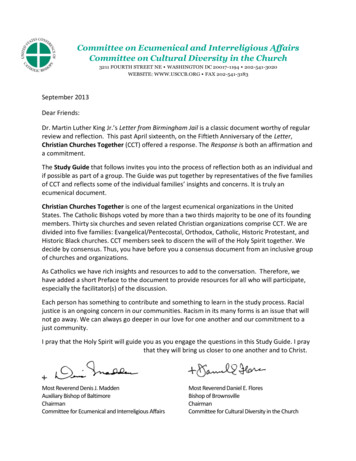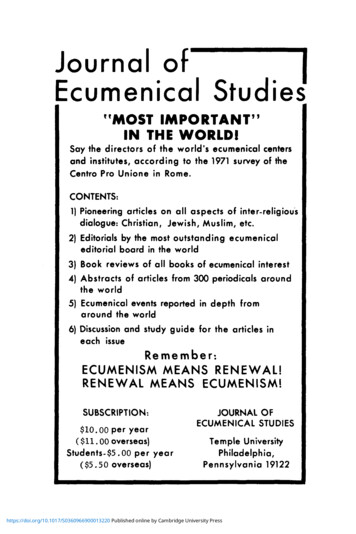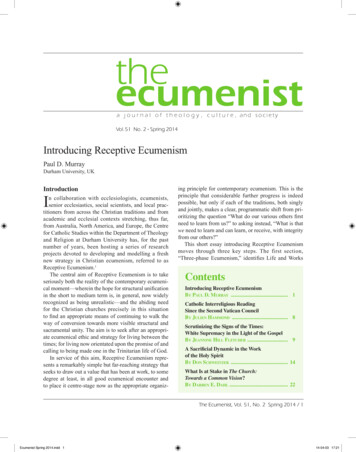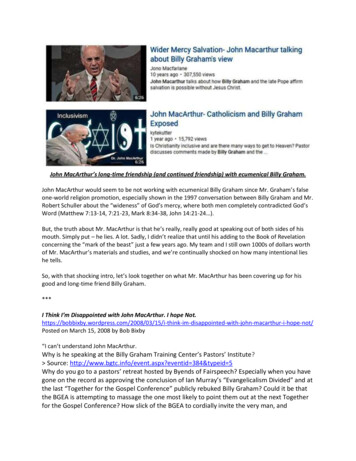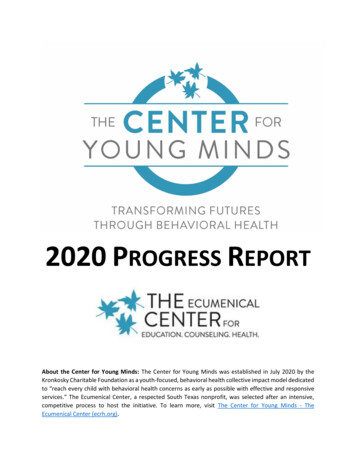
Transcription
2020 PROGRESS REPORTAbout the Center for Young Minds: The Center for Young Minds was established in July 2020 by theKronkosky Charitable Foundation as a youth-focused, behavioral health collective impact model dedicatedto “reach every child with behavioral health concerns as early as possible with effective and responsiveservices.” The Ecumenical Center, a respected South Texas nonprofit, was selected after an intensive,competitive process to host the initiative. To learn more, visit The Center for Young Minds - TheEcumenical Center (ecrh.org).
History and BackgroundThe Center for Young Minds was initially a collaboration between two San Antonio foundations(Kronkosky Charitable Foundation; San Antonio Area Foundation), and two philanthropicleaders (Barbara B. Gentry; Harvey Najim). This group of individuals and foundations sought toaddress youth behavioral health – to focus on changes that would result in lasting, positiveoutcomes for Bexar County families.A needs assessment pertaining to youth behavioral health was conducted, and communityorganizations convened to determine potential next steps. Synergy grew to the point thatKronkosky Charitable Foundation initiated a request for proposal process to identify a backboneorganization that could utilize a collective impact framework to move the work forward.After seven months of community review and input,The Ecumenical Center was chosen to lead thebackbone entity creation within their organization.Within 30 days of the award, leadership for theeffort was onboarded, and with feedback fromcommunity, the name “Center for Young Minds”was chosen.A more detailed timeline is noted in Figure 1.0.Figure 1.0 – Center for Young Minds TimelineThe Center for Young Minds, an initiative hosted by The Ecumenical Center – 2020 Progress Report Page 2 of 77
The Problems to Solve, Data Indicators Selected and the MissionIn 2019, community leadership identified three primary problems within youth behavioralhealth that should be addressed, as shown in Figure 2.0:Figure 2.0 – The Problems to be AddressedFrom these problems, five data indicators at the population level were agreed upon.Community utilized a Results Based AccountabilityTM approach, by initially brainstormingvarious measures, and then applying filters of “high”, “medium” or “low” ratings forcommunication power, importance power, and data power, as shown in Figure 3.0.Figure 3.0 – How Community Chose the IndicatorsIf a data indicator was deemed “high” in communication and importance power, yet “low” or“medium” in data power, the indicator was deemed valuable enough to establish a datadevelopment agenda. Three of the five indicators community prioritized to track and measureThe Center for Young Minds, an initiative hosted by The Ecumenical Center – 2020 Progress Report Page 3 of 77
fell into this area, where we will need to establish the data from the ground up. The dataindicators that require a data development plan include: Data Development Indicator: Youth utilization rate of continuum of care In workgroups, community will determine what facets of a continuum of care(see an example in Figure 4.0) will be included in the visual of the behavioralhealth of youth in Bexar County. The goal is to represent the continuum of carenot just from a crisis perspective (hospitalizations, law enforcementengagement, suicide attempts) but from the wellness spectrum, too. Wellnessmay include tracking the raw number of visits to a service provider, participationin peer support groups, or even number of anti-stigma education materialsdistributed at a community event. With some maturity in the tracking andevaluation of this measure, the possibility exists of plotting raw numbers againsta denominator that speaks to the need at each point on the continuum.Figure 4.0 – Continuum of Care Data Development Indicator: Duration of symptoms Nationally, we know that most youth never receive treatment for theirsymptoms. If treatment is sought, the average delay from the onset of symptomsis eight to 10 years. This indicator would need to create a common method forThe Center for Young Minds, an initiative hosted by The Ecumenical Center – 2020 Progress Report Page 4 of 77
tracking this measure across multiple systems. Potential connection points maybe the Health Information Exchange, Signify and/or multiple other systems. Data Development Indicator: System capacity – asset driven When behavioral health capacity is tracked, it’s often against metrics of theextreme shortage of psychiatrists, including child and adolescent psychiatristsand psychologists. Yet, when thinking of upstream and preventive approaches,youth ministers, coaches, counselors, social workers, community health workers,promotoras and others invested in youth development could be an integral partof the solution. This indicator would track capacity based on upstreamapproaches for youth behavioral health. Additionally, the indicator may track ata program level versus provider level. With the onset of COVID-19, manyorganizations pivoted successfully to virtual delivery of services, possiblyexpanding reach. Multiple possibilities exist around this indicator anddetermining system capacity.Two indicators have pathways to be measured, including student absenteeism and schooldisciplinary action by type. These two indicators have the ability to be disaggregated by avariety of factors, including ethnicity.By addressing these three problems (one in five youth have a behavioral health need; mosttreatment is delayed, if sought; youth are self-medicating with substance abuse), trackingoutcomes through five population level indicators, the goal set forth by community is to:To reach every child with behavioral health concernsas early as possible with effective and responsive services.Staffing and OnboardingWith funding from Kronkosky Charitable Foundation in place as of July 2020, an Executive VicePresident was hired and onboarded in August, and a Project Coordinator was onboarded inOctober. Both staffers have completed Trauma Informed Care training, in anticipation of TheEcumenical Center’s certifying process, a separate but aligned collective impact effort hosted atthe nonprofit. Additionally, both staffers have completed Peer Support Training and becomecertified for a three-year period in Youth Mental Health First rh.orgAraceli CalvilloRebecca HelterbrandExecutive Vice Presidentrhelterbrand@ecrh.orgThe Center for Young Minds, an initiative hosted by The Ecumenical Center – 2020 Progress Report Page 5 of 77
Naming ProcessIn September of 2020, The Ecumenical Center engaged a respected marketing firm to developpossible name options for the formerly named Bexar County Children & Youth BehavioralHealth Initiative. Guidelines for the name included being consumer-friendly, while avoiding anygeographic references, as this initiative seeks to be replicated across South Texas once positive,replicable outcomes are achieved. A slate of name options was developed. Some of the initialnames were deemed non-viable, for example, “Healing Young Minds” is far too close to aknown and reputable local nonprofit’s tagline. Viable names were moved forward fordiscussion with Kronkosky Charitable Foundation, and a survey was developed for leadersengaged with the 2019 process, and members of the 2020 RFP Selection Committee.The survey was designed using best practices from a reputable online survey tool, and sharedwith a total of twelve individuals from the aforementioned committees. Recipients wereprovided with eight days’ notice to complete the survey, and a reminder was sent 24 hoursbefore the survey was closed. A total of ten responses were received.A clear choice was indicated in the name, the Center forYoung Minds. The name has been searched fortrademark availability, and steps are being taken toensure ownership of this name. Graphically, the logo isrequired to mirror the branding standards of TheEcumenical Center, but with enough uniquecharacteristics to stand on its own as a communityeffort. Finally, a series of taglines were developed, andin a community input session, attendees voted at a rateof 67% to adopt the following: “Transforming FuturesThrough Behavioral Health”. This tagline providesrelevant context to the purpose and intentionality of the Center for Young Minds.Infrastructure and GovernanceIn the initial absence of a defined steering committee of community leaders, KronkoskyCharitable Foundation hosted regularly scheduled meetings, gauging the progress of the effort.Kronkosky Charitable Foundation requested that a governance structure be drafted, inanticipation of a steering committee being established in the first quarter of 2021.The infrastructure framework is based on best practices of collective impact (see Figure 5.0),which for the Center for Young Minds initiative also includes person-centered design and socialjustice (not typically a part of collective impact) as well as Results Based AccountabilityTMprinciples. Also included are Design Justice Network Principles within our framework, whichrethinks processes, centers people who are normally marginalized by design, and usescollaborative, creative practices to address the deepest challenges our communities face.The Center for Young Minds, an initiative hosted by The Ecumenical Center – 2020 Progress Report Page 6 of 77
Figure 5.0 – Infrastructure DesignLocated within Addendum A is an outline of the steering committee’s desired characteristics,responsibilities, ground rules, decision-making processes, along with other processes, such asvacancies and conflict of interest. Also included in Addendum A are similar approaches for theworkgroups that will be formed, and the backbone’s structure and accountability mechanisms.Youth Voice and InputMultiple nonprofit organizations that serve youth directly and through schools were engaged inan effort to gain youth voice and input into behavioral health needs and supports. Theapproach was to offer virtual, guided discussions online with small groups of youth of similarages. A clinician was available to any youth who may have been triggered by the discussion. Thefull methodology was piloted in partnership with Rise Recovery’s young adult counselors todetermine if any adjustments would be needed.A parent/guardian authorization was completed online, prior to the young person’sparticipation. An email survey link was shared with the participant following the session, andyouth received a 10 gift card as a thank you.In two instances, a face-to-face group was held in a socially distanced setting. In total, 14 onehour, in-depth sessions were held, encompassing 40 youth during September and October of2020.The Center for Young Minds, an initiative hosted by The Ecumenical Center – 2020 Progress Report Page 7 of 77
Addendum B contains the full report, along with a list of participating organizations, thediscussion format, and the parent/guardian authorization form. The report was shared withcommunity via virtual input sessions in November and December of 2020, and was posted onThe Ecumenical Center’s website. Additional outreach plans to share the study widely will occurin early 2021. A summary of the findings is noted on Figure 6.0.Figure 6.0 – Summary of Youth Voice and Input StudyTo ensure that youth voice and input isn’t “token” in nature, youth that participated in thestudy were invited to stay engaged in the effort. In December of 2020, youth began coalescingin a youth-driven fashion, beginning to shape how their input can continue to be incorporatedinto the outcomes sought.Positive Childhood ExperiencesThe San Antonio community and as well as our nation have become much more aware of theAdverse Childhood Experiences (ACEs) scale and have likely taken the ACEs quiz themselves.ACEs predicts, based on measuring the number of traumatic or adverse events experienced,which individuals are likely to struggle into adulthood, eventually leading to shorter lifespanswith the co-morbidity of physical illnesses.A small percentage of youth with high ACEs scores somehow have normal development,despite the adverse experiences. This resiliency can create a pathway to help youth who haveThe Center for Young Minds, an initiative hosted by The Ecumenical Center – 2020 Progress Report Page 8 of 77
encountered ACEs or may in the future. This work can be complementary to the immense effortcommunities have engaged in to reduce ACEs. While we work to reduce ACEs, we can also beworking collaboratively to increase resiliency. In summary, how do we move toward developingresiliency, starting in childhood?A study released in 2019 by researchers at Johns Hopkins University sought to identify“Protective Childhood Experiences” (PCEs) that are the keys to resilience in spite of ACEsencountered. Seven PCEs were identified from the large-scale study of more than 6,000 adults,and are noted in Figure 7.0.The hallmark of resilience is social connections, and social connectedness is linked to adultmental health. Adult survey respondents who reported high levels of adulthood social andemotional support (e.g., family, partners, and friend circles they trusted, were open with, andlooked to for support) were more likely to have experienced a high number of PCEs during theirchildhood.Kids who experience many PCEs during childhood become adults who can seek support and getcare, and adults who have this ability have improved symptoms even if mental illness ispresent. The relationship between PCEs in childhood and good mental health in adults is “doseresponsive”, meaning that the more PCEs a child receives, the better their adult mental healthis likely to be.Figure 7.0 – Seven Positive Childhood ExperiencesThe Center for Young Minds, an initiative hosted by The Ecumenical Center – 2020 Progress Report Page 9 of 77
Community Input Cultivation ProcessWith guidance from Kronkosky Charitable Foundation, a series of virtual community inputsessions were planned and held in November and December of 2020. The goal was to take thework initiated in 2019, and reset relevant strategies through three perspectives, as follows: Youth voiceThe learnings of living through a pandemicPerspectives that were not present during the 2019 in-person community sessionsTo get to the point of hosting these sessions effectively, attendees from 2019 weredocumented and the source of their perspective was analyzed. It was determined that the faithperspective, nonprofits serving youth but not providing behavioral health services, funders,youth and parent voice was needed.To solve the youth voice issue and its immense importance in the process, the aforementionedstudy was developed and published. This study was incorporated into each community inputsession.Parent perspective was sought through the local National Alliance on Mental Illness (NAMI)chapter, and through Head Start Councils with guidance from the City of San Antonio andFamily Service Association. These organizations helped to recommend and source individualswho could participate in the virtual community input sessions.As a result of an intense outreach effort, the original list of community leaders who participatedin 2019, which was comprised of around 100 individuals, had 73 individuals added, and 23individuals who have transitioned their role were removed.This work expanded the number of organizations, voices and perspectives weighing in onstrategies to move the process forward. Catholic, Baptist and Jewish faiths were included in theprocess, multiple nonprofits who serve youth (but don’t focus on behavioral health)participated, multiple parents engaged, and in terms of funders, Methodist HealthcareMinistries, H.E. Butt Foundation, and friends of local community leader, Barbara Gentry, wereheavily involved.Developing Facilitators to Support the Virtual EffortFacilitators who supported the work in 2019 were solicited to engage in the 2020 process. Mostwere able to commit to the Center for Young Minds. However, with the nature of virtualsessions, two facilitators in a meeting no longer worked. Projections were for three virtualbreakout sessions, with two facilitators PER breakout. A minimum of six individuals would needto provide facilitation support at every single virtual meeting.The Center for Young Minds, an initiative hosted by The Ecumenical Center – 2020 Progress Report Page 10 of 77
While the Center for Young Minds staff could assist, at a minimum, one person would have tostay in the main session, managing broadcast messages, admitting people who were in thewaiting room back into a session, etc.Volunteers were solicited to engage in this work. In total, seven individuals supported theeffort. Only two of the individuals had past experience, so bringing the entire group up to thesame level of knowledge required multiple onboarding sessions.In total, it’s estimated that facilitators serving every single community input session invested 32hours of time in prep meetings, hosting breakout sessions, debriefings, etc., for the two-monthprocess. A couple of our facilitators engaged in half of the community meetings. Their work wasinvaluable to our outcomes, and as such, they are being named for recognition: Leticia Callanen, City of San AntonioNoemi Villarreal, United Way of San Antonio and Bexar CountyDenise Sample, Community at LargeAlec Chapa, Chapa ConsultingLisa Hurst, Improv to GrowMonica Cruz, Texas State University FreshmanStructuring the Community Input Sessions for SuccessIn collaboration with facilitators, four community input virtual sessions were scheduled at theend of 2020, based on responses from attendees on relative availability from a doodle poll.These sessions were created utilizing the ZoomTM platform.Attendees were asked to register so that breakout session composition could be determined inadvance. All attendees were provided with the 2019 Factors and Strategies documentation,along with a glossary. A brief presentation on the Center for Young Minds was also provided toground attendees in the community goal, the problems to be addressed and other importantelements.Because attendees could register for all or some of the sessions, anyone who missed the firstsession was provided with an edited video of the core content from the inaugural meeting.Following each meeting, surveys were issued to gain insight into areas of success, andopportunities for improvement. Survey results were extremely complementary of the intenseplanning and collaboration across the facilitation team. Figure 8.0 shares summary surveyresults.The Center for Young Minds, an initiative hosted by The Ecumenical Center – 2020 Progress Report Page 11 of 77
Figure 8.0 – Summary Survey ResultsAttendance at the virtual events exceeds what was possible in 2019 via in-person meetings, asshown in Figure 9.0 – Attendee Comparison. In total nearly 90 individuals participated in theinput process in 2020, representing 45 unique organizations; parents, youth and retiredcommunity leaders also engaged.First MeetingSecond MeetingThird MeetingFourth Meeting20192020CommentsAttendees* Attendees23452019’s first meeting was in September; 2020’swas held on November 11.33542019’s second meeting was in October; 2020’swas held on November 18.24522019’s third meeting was in November; 2020’swas held on December 825332019’s final meeting was in December; 2020’sfinal meeting was held on December 15*2019’s attendance reports included hosts and facilitators. 2020’s attendance does NOT include hosts and facilitators,especially due to the large number of support staff needed to ensure success in a virtual approach.Figure 9.0 – Attendee ComparisonPerhaps the most important outcome which indicates success of the community input sessionsis not within the survey results, but rather when the intentional and measured changes to thestrategies. Included in Addendum C is the set of strategies, which were created, reviewed andupdated by community.The Center for Young Minds, an initiative hosted by The Ecumenical Center – 2020 Progress Report Page 12 of 77
2021 PlansAll attendees of the community input sessions will receive a survey designed by our datapartner, CI:Now. The survey will ask community to a) rank in order of importance the factors ofeach indicator, and b) to rate the relative importance and urgency of the strategies within eachindicator.Based on the survey results, which are expected to be published in January, or at the latest,February of 2021, targeted workgroups aligned around the will of the community shall beestablished.A steering committee will also be enacted, to provide oversight into the process. As workgroupsdevelop recommendations, the steering committee will vote upon those recommendations.Strategies deployed will be monitored by our data partner, CI:Now, who will also provideworkgroups intense support around evidence-based practices and other data needs.Parallel to these processes, a youth council has been formed which will be youth-led and youthdirected to continue informing and guiding the work ahead.Outcomes will be tracked, and as strategies are deployed, additional strategies will be queuedfor deployment, as we work collaboratively, steadfastly toward our mission:To reach every child with behavioral health concernsas early as possible with effective and responsive services.The Center for Young Minds, an initiative hosted by The Ecumenical Center – 2020 Progress Report Page 13 of 77
Addendum AGovernanceThe Center for Young Minds, an initiative hosted by The Ecumenical Center – 2020 Progress Report Page 14 of 77
The Center forYoung MindsGovernance Structure and GuidelinesOctober 2020The Center for Young Minds, an initiative hosted by The Ecumenical Center – 2020 Progress Report Page 15 of 77
IntroductionThis document provides a framework for The Center for Young Minds infrastructure, to includegovernance components. The framework is based on best practices of Collective Impact, whichfor our initiative also includes person-centered design and social justice (not typically a part ofcollective impact) as well as Results Based AccountabilityTM principles. Also included are DesignJustice Network Principles within our framework, which rethinks processes, centers people whoare normally marginalized by design, and uses collaborative, creative practices to address thedeepest challenges our communities face.The problems identified for this initiative, along with a common agenda/purpose and data to becollected are annotated in Appendix A. Included in these guidelines are the workings of theSteering Committee, Workgroups and Backbone.The Center for Young Minds, an initiative hosted by The Ecumenical Center – 2020 Progress Report Page 16 of 77
Steering CommitteeSteering Committee Member Characteristics Decision Makers: Members should be at the CEO/President Level and able to drive systemschange relevant to effortInfluential Champions: Command respect of broader set of stakeholders (and perceivedso). Can bring stakeholders and funders to the table and keep them there. Can championthe strategy with the broader communityContent Expertise/Practitioners: Familiar with subject matter to contribute substantivelyPassion and Urgency: Passionate about issue and feel real urgency for the need to changeFocused on the Greater Interest: Represent needs of their own organizations but able tothink and act in the greater interest of the communityCommitment: Willing and able to commit time and energy to attend meetings and get workdoneLived Experience: Residents or community members with lived experience on the issuebeing addressed by the initiativeCulturally Relevant: The overall composition of the committee must be representative ofthe demographic makeup of the community it serves.The Steering Committee may also designate a community leader in the role of “advisor”. Thisdesignation means that the community leader agrees to provide input and voice to theinitiative, but is not required to meet the attendance guidelines of a fully-invested member ofthe Steering Committee. This option may allow (for example) a busy physician or legislativeleader to engage with the work of the Steering Committee in an ad-hoc fashion, without themeeting attendance requirements. Steering Committee members must agree to the personbeing named to the advisor role.Steering Committee members will be a mixture of Workgroup co-chair representation, andperspectives from various ecosystems in our community, including but not limited to faith;education; parent/guardian; youth; nonprofit; substance abuse; philanthropy; clinical; andcity/county. To keep the Steering Committee agile, a Workgroup co-chair may dually representan ecosystem perspective (if appropriate).Steering Committee Member ResponsibilitiesGuidance, Vision, and Oversight Develop and refine common agenda/purpose for change, including problem statement,goal(s), and guiding principles Use data to inform strategy development and learningThe Center for Young Minds, an initiative hosted by The Ecumenical Center – 2020 Progress Report Page 17 of 77
Track progress of work using agreed-upon indicators at Steering Committee and workgrouplevelsMake connections between workgroups to ensure coordination and efficiencyLeverage personal and professional relationships to bring awareness, partnerships andfunding to the initiativeInteract with the backbone entity on strategy, community engagement, and sharedmeasurementLeadership Consider how your individual organization or those in your network can align with thepurpose of the Center for Young Minds Serve as a vocal champion of the collective impact effort in the community Honor the guiding principles and ground rules established for effective collaborationProcess Participate (virtually or when appropriate, in-person) in regularly scheduled meetings. Attendance is expected at regularly scheduled meetings at a rate of 85% in a calendar year.Attendance is critical to building momentum and sustaining the work. Missing twoconsecutive meetings, or more than two meetings in a four-month period will initiate aprobationary period and may result in resignation of membership. Pre-identification of a delegate with decision-making authority at a maximum of twomeetings in a calendar year to remain in compliance with participation is allowable. Review pre-read materials prior to meetings and come prepared for engaged discussion,active listening, and respectful dialogue Commit to a two-year membership in the Steering Committee, with an option for a twoyear renewal as mutually agreed.Discontinuation of a Steering Committee Member’s TermThe term of Steering Committee member may end due to any one of the following scenarios: Change in their role within the community making them no longer eligible for thevoice/perspective in which they were chosen to represent. The steering committee member or their representative organization is unable to meet theroles outlined as a responsibility for membership, including meeting attendance.If applicable, such as in the case of attendance, the member will be notified that they areapproaching a probationary period covering two meeting cycles. A member who enters asecondary probationary period in a span of 12-months will be considered for immediatediscontinuation of serviceThe Center for Young Minds, an initiative hosted by The Ecumenical Center – 2020 Progress Report Page 18 of 77
If attendance does not improve, or the removal is for reason(s) beyond attendance, afterSteering Committee consensus, it may be deemed appropriate to immediately excuse the termof said member.The Steering Committee will determine the most appropriate person to dialogue with theaffected member. Personal dialogue with the non-compliant member occurs, and the reason(s)for discontinuation of service will be shared. The member will have an opportunity to share anypertinent information back with the overall Steering Committee, if desired, through themember who engaged the personal dialogue about ending service to the committee.The Steering Committee shall then identify possible replacements for the vacant position, giventhe perspective and voice that the originating member represented. A final representative willbe named utilizing consensus. The Committee shall identify the most appropriate person (basedon relationships) on the Committee to solicit the candidate for membership and report back tothe Committee the results.Vacancies on the Steering CommitteeA vacancy on the Steering Committee shall be filled by understanding the voice and perspectiveof the originating member and the representation therein. Prospective candidates shall bediscussed by the full Steering Committee and utilizing consensus, a final candidate will beagreed upon.The Committee shall identify the most appropriate member to solicit the candidate formembership and report back to the Committee the results. A candidate who accepts willcomplete the signatory on the commitment letter noted in Appendix B. If the candidatedeclines, the slate of names will be reopened and discussed, with the option for additionalnames to be considered.Conflicts of InterestIn a community-based and led collective impact approach, conflicts of interest will invariablyarise. Conflicts of interest may be real or perceived. Prior to any decisions being made by theSteering Committee, a call for any conflicts of interest will be made by the Executive VicePresident of the Center for Young Minds. It is expected that an open, honest and authenticdialogue of conflicts will be shared at that time, and a member may recuse themselves from thedecision-making process.Also related to this topic is an established ground rule that requires systems thinking, where noone individual’s need or a specific nonprofit can
Kronkosky Charitable Foundation initiated a request for proposal process to identify a backbone organization that could utilize a collective impact framework to move the work forward. After seven months of community review and input, The Ecumenical Center was chosen to lead the backbone entity creation within their organization. .




